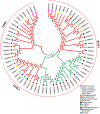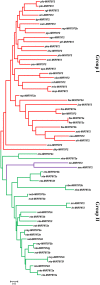Systematic analysis of DEMETER-like DNA glycosylase genes shows lineage-specific Smi-miR7972 involved in SmDML1 regulation in Salvia miltiorrhiza
- PMID: 29739980
- PMCID: PMC5940787
- DOI: 10.1038/s41598-018-25315-w
Systematic analysis of DEMETER-like DNA glycosylase genes shows lineage-specific Smi-miR7972 involved in SmDML1 regulation in Salvia miltiorrhiza
Abstract
DEMETER-like DNA glycosylases (DMLs) initiate the base excision repair-dependent DNA demethylation to regulate a wide range of biological processes in plants. Six putative SmDML genes, termed SmDML1-SmDML6, were identified from the genome of S. miltiorrhiza, an emerging model plant for Traditional Chinese Medicine (TCM) studies. Integrated analysis of gene structures, sequence features, conserved domains and motifs, phylogenetic analysis and differential expression showed the conservation and divergence of SmDMLs. SmDML1, SmDML2 and SmDML4 were significantly down-regulated by the treatment of 5Aza-dC, a general DNA methylation inhibitor, suggesting involvement of SmDMLs in genome DNA methylation change. SmDML1 was predicted and experimentally validated to be target of Smi-miR7972. Computational analysis of forty whole genome sequences and almost all of RNA-seq data from Lamiids revealed that MIR7972s were only distributed in some plants of the three orders, including Lamiales, Solanales and Boraginales, and the number of MIR7972 genes varied among species. It suggests that MIR7972 genes underwent expansion and loss during the evolution of some Lamiids species. Phylogenetic analysis of MIR7972s showed closer evolutionary relationships between MIR7972s in Boraginales and Solanales in comparison with Lamiales. These results provide a valuable resource for elucidating DNA demethylation mechanism in S. miltiorrhiza.
Conflict of interest statement
The authors declare no competing interests.
Figures








Similar articles
-
Genome-wide analysis and molecular dissection of the SPL gene family in Salvia miltiorrhiza.J Integr Plant Biol. 2014 Jan;56(1):38-50. doi: 10.1111/jipb.12111. Epub 2013 Nov 20. J Integr Plant Biol. 2014. PMID: 24112769
-
Characterization of the polyphenol oxidase gene family reveals a novel microRNA involved in posttranscriptional regulation of PPOs in Salvia miltiorrhiza.Sci Rep. 2017 Mar 17;7:44622. doi: 10.1038/srep44622. Sci Rep. 2017. PMID: 28304398 Free PMC article.
-
Comparative analysis of the Dicer-like gene family reveals loss of miR162 target site in SmDCL1 from Salvia miltiorrhiza.Sci Rep. 2015 May 13;5:9891. doi: 10.1038/srep09891. Sci Rep. 2015. PMID: 25970825 Free PMC article.
-
Molecular cloning and expression analysis of WRKY transcription factor genes in Salvia miltiorrhiza.BMC Genomics. 2015 Mar 17;16(1):200. doi: 10.1186/s12864-015-1411-x. BMC Genomics. 2015. PMID: 25881056 Free PMC article.
-
[Salvia miltiorrhiza as medicinal model plant].Yao Xue Xue Bao. 2013 Jul;48(7):1099-106. Yao Xue Xue Bao. 2013. PMID: 24133975 Review. Chinese.
Cited by
-
Genome-Wide Identification and Characterization of miRNAs and Natural Antisense Transcripts Show the Complexity of Gene Regulatory Networks for Secondary Metabolism in Aristolochia contorta.Int J Mol Sci. 2024 May 30;25(11):6043. doi: 10.3390/ijms25116043. Int J Mol Sci. 2024. PMID: 38892231 Free PMC article.
-
Decoding the sorghum methylome: understanding epigenetic contributions to agronomic traits.Biochem Soc Trans. 2022 Feb 28;50(1):583-596. doi: 10.1042/BST20210908. Biochem Soc Trans. 2022. PMID: 35212360 Free PMC article.
-
Characteristics of Salvia miltiorrhiza methylome and the regulatory mechanism of DNA methylation in tanshinone biosynthesis.Hortic Res. 2023 May 31;10(7):uhad114. doi: 10.1093/hr/uhad114. eCollection 2023 Jul. Hortic Res. 2023. PMID: 37577393 Free PMC article.
-
Base Excision DNA Repair in Plants: Arabidopsis and Beyond.Int J Mol Sci. 2023 Sep 29;24(19):14746. doi: 10.3390/ijms241914746. Int J Mol Sci. 2023. PMID: 37834194 Free PMC article. Review.
-
Characterization and differential expression of DNA methyltransferase and demethylase genes in response to abiotic stress in Isodon rubescens.BMC Plant Biol. 2025 Jun 4;25(1):755. doi: 10.1186/s12870-025-06769-3. BMC Plant Biol. 2025. PMID: 40468179 Free PMC article.
References
Publication types
MeSH terms
Substances
LinkOut - more resources
Full Text Sources
Other Literature Sources

